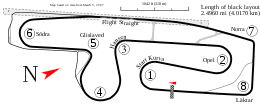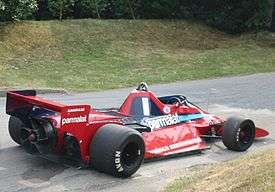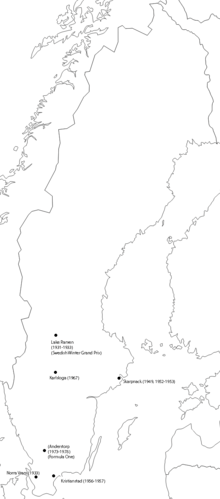Swedish Grand Prix
| Scandinavian Raceway | |
 | |
| Race information | |
|---|---|
| Number of times held | 9 |
| First held | 1931 |
| Last held | 1978 |
| Most wins (drivers) |
|
| Most wins (constructors) |
|
| Circuit length | 4.031 km |
| Race length | 282.170 km |
| Laps | 70 |
| Last race (1978) | |
| Pole position | |
| |
| Podium | |
| |
| Fastest lap | |
| |
The Swedish Grand Prix (Swedish: Sveriges Grand Prix) was a round of the Formula One World Championship from 1973 to 1978. It took place at the Scandinavian Raceway in Anderstorp (Gislaved Municipality), about 30 kilometres (19 mi) from Jönköping, in Småland, Sweden. The 1930s also saw two races carry the title, the Swedish Summer Grand Prix and an ice race, the Swedish Winter Grand Prix, similar to races held in Estonia, Finland and Norway.
In the 1960s there were Formula Two races held called Swedish Grand Prix.
History
Origins
While racing in Sweden had a long history it was not until 1931 that a race was first titled Grand Prix. The first Swedish Winter Grand Prix was held on a mammoth 46 kilometre circuit near Lake Rämen about 2 hours northwest of Stockholm in the snow and freezing cold with a lap time of approximately 35 minutes.[1] In 1933 the first Swedish Summer Grand Prix was held on a 30 kilometre cricuit at Norra Vram not far north from Malmö, a race which can be better compared to modern Grands Prix. The opening lap saw a multi-car pile-up which saw several drivers injured, two seriously, and a riding mechanic was killed. One of the crashed cars started a fire which saw a nearby house burned to the ground.[2] The race continued while emergency services attended the scene and the race was eventually won by Antonio Brivio (Alfa Romeo). Major racing came to a halt after that.[3] There were three sports cars races held between 1955 and 1957, with the latter two being part of the World Sportscar Championship, meanwhile 1967, the name Swedish Grand Prix was, as a one-off name, given to that year's Kanonloppet in Karlskoga. It was run to Formula Two rules and Jochen Rindt won.[4]
Anderstorp
Ronnie Peterson's success with Team Lotus was the catalyst for a Swedish Grand Prix and the race was held for the first time in 1973 at the grandly-named Scandinavian Raceway, about 2 hours east of Gothenburg in the middle of southern Sweden- this circuit was very isolated and people often either camped out or stayed in other people's homes- of which there were far and few in between. Peterson did not disappoint his fans in qualifying, taking pole in his Lotus. For 70 laps it looked like this was going to be a one-two for Team Lotus with Peterson first and world champion Emerson Fittipaldi second. However disaster struck when Fittipaldi retired with gearbox failure. Meanwhile, Denny Hulme was quickly closing the gap on the lead, Peterson having major trouble with tire wear and fighting to stay on the track. On the 79th and penultimate lap Hulme was able to pass the local hero to snatch victory, the New Zealander's decision to run harder tires on his McLaren-Cosworth having paid off. Peterson was second. That was as close as any Swede came to winning on home soil. It is worth noting that during the 1973 season, the Cosworth DFV V8 engine powered to victory in every single race in the 15 race season, a performance never to be repeated. In 1974 the Swedish Grand Prix was totally dominated by the two Tyrrell-Cosworth 007s of Jody Scheckter and Patrick Depailler. It was the Frenchman who took pole in front of his teammate, however Scheckter beat him by 0.380 sec in the race. This was the South African's first Grand Prix win.
In Austrian Niki Lauda's second year with the Prancing Horse the team provided him with the 312T - a car that was technically far superior to any of the competition. He won his first world title that year with 5 wins and a huge margin over second place in the championship. At Anderstorp he took his third consecutive win of the season after the Monaco and Belgian Grands Prix. Qualifying resulted in pole position for Vittorio Brambilla in his March, Lauda qualified fifth fastest and his teammate Clay Regazzoni 11th. In the race Brambilla took the lead, but by lap 16 he was overtaken by Carlos Reutemann's Brabham. Meanwhile, Lauda was steadily progressing through the field and on lap 42 he was second. He put a series of fastest laps, closed on Reutemann and overtook him to win the Grand Prix by 6 seconds. Reutemann finished second with Regazzoni in the second Ferrari 312T third. The 1976 Swedish GP saw the first (and only) win of a 6-wheel car - the Tyrrell P34. The theory was that its four tiny front wheels would increase mechanical front-end grip – with more rubber on the road – and thus eliminate understeer while at the same time improve cornering and braking. When it was revealed it was the instant sensation of the 1976 season. The car was a photo opportunity on wheels – six of them, which was precisely why – and must have given Elf more free publicity in the 1976 pre-season and beyond than it garnered during the whole of 1974 and 1975. Tyrrell's Jody Scheckter took pole, with Patrick Depailler in fourth. In the race the Tyrrells strode imperiously to a crushing one-two. The South African, who when later probed confided that he thought the six-wheeled concept ridiculous, was beaming on the podium. However the Swedish walkover proved to be a fluke, and the P34 never won a race again. At Anderstorp, Jacques Laffite in his Gitanes sponsored Ligier-Matra put in a commanding display, romping to victory in the 1977 Swedish GP. France had been put back on the map: that was the first time that a French car with a French engine, backed by a French company, and driven by a French driver had won a Grand Prix.
The 1978 race and the Brabham Fan Car

The 1978 Swedish GP itself being rather uneventful, it was the winning car that created its own footnote in history by dominating the meeting, thus to great lengths contributing to its uneventfulness in the first place. Responsible for this overwhelming coup was some clever thinking by Brabham's Gordon Murray, who was trying to eclipse Colin Chapman's ground effect invention on the Lotus 79, the skirted car that had swept the front row since its debut at Zolder. Center of the new Brabham BT46B 'Fancar' concept was a huge fan taking ground effect to a higher level (at least engineering-wise) by pulling a vacuum from under the bottom of the car, thereby creating an enormous amount of downforce. Its legality was soon protested, but it was allowed to race, Niki Lauda and John Watson qualifying 2nd and 3rd behind the Lotus 79 of Mario Andretti. Andretti eventually dropped out due to a broken valve, allowing Lauda into the lead. Once a back-marker dropped oil onto the track, the Brabham was in a race of its own, seemingly unaffected by the slippery surface. Lauda went on to win by 34.6 seconds. The fan car was later voluntarily withdrawn by Brabham, and never raced again. The car had, however, been deemed legal, allowing the win to stand, however, which cost Arrows their chance of victory in their debut season.
There has been no Swedish Grand Prix after 1978. The deaths in 1978 of both Ronnie Peterson and Gunnar Nilsson contributed to the demise of this round of the world championship, as interest for Formula One in Sweden fell following the death of the two Swedish racers. The race was scheduled to be held as part of the 1979 season, but it was cancelled early on.
Winners
Events which were not part of the Formula One World Championship are indicated by a pink background.
Note: the races before 1956 were formally called the Swedish Summer Grand Prix.
Multiple winners (drivers)
| # Wins | Driver | Years Won |
|---|---|---|
| 2 | |
1975, 1978 |
| |
1974, 1976 | |
Multiple winners (constructors)
Embolded teams are still competing in the Formula One championship
A pink background indicates an event which was not part of the Formula One World Championship.
| # Wins | Constructor | Years Won | |
|---|---|---|---|
| 2 | |
1956, 1975 | |
| |
1974, 1976 | ||
| |
1949, 1957 | ||
List of winners by year

| Year | Driver | Constructor | Location | Report |
|---|---|---|---|---|
| 1978 | |
Brabham-Alfa Romeo | Anderstorp | Report |
| 1977 | |
Ligier-Matra | Report | |
| 1976 | |
Tyrrell-Ford | Report | |
| 1975 | |
Ferrari | Report | |
| 1974 | |
Tyrrell-Ford | Report | |
| 1973 | |
McLaren-Ford | Report | |
| 1972 - 1968 |
Not held | |||
| 1967 | |
Matra-Cosworth | Karlskoga | Report |
| 1966 - 1958 |
Not held | |||
| 1957 | |
Maserati | Kristianstad | Report |
| 1956 | |
Ferrari | Kristianstad | Report |
| 1955 | |
Mercedes-Benz | Kristianstad | Report |
| 1954 | Not held | |||
| 1953 | |
EL Special | Skarpnäck | Report |
| 1952 | |
Mercury Ardun Special | Skarpnäck | Report |
| 1951 - 1950 |
Not held | |||
| 1949 | |
Maserati | Skarpnäck | Report |
| 1948 - 1934 |
Not held | |||
| 1933 | |
Alfa Romeo | Norra Vram | Report |
External links
References
- ↑ Grand PRIX RÄMENLOPPET 1933, SF-journalen, Film 1933
- ↑ "1933 Mannin Moar, Dieppe GP, Coppa Ciano, Swedish and Nice GPs". Kolumbus.fi. Retrieved 2012-11-08.
- ↑ "Tracks-Nordic Countries". Kolumbus.fi. Retrieved 2012-11-08.
- ↑ http://www.racingsportscars.com/championship/World%20Championship.html